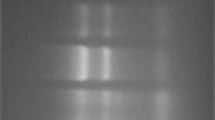Abstract
Background
This study aimed too evaluate the proliferation and apoptosis of human ovarian cancer cell lines HO8910 and SKOV3 after exposure to a simulated laparoscopic carbon dioxide (CO2) pneumoperitoneum environment at different pressures and lengths of exposure time.
Methods
The effects of the simulated laparoscopic CO2 pneumoperitoneum environment at different CO2 pressures (0–16 mmHg) and exposure times (1–4 h) on tumor cell growth and apoptosis were assessed by 3-[4,5-Dimethylthiazol]-2; 5-diphenyltetrazolium bromide (MTT) chromometry and proliferative index (PI) staining or Annexin V and PI double-staining flow cytometry. Cells cultured in a standard environment were used as the control group.
Results
In this study, HO8910 cell growth tended to slow down with the increase in CO2 pressure and exposure time. A significantly lower PI was observed at 72 h of culture after exposure to both 8 and 16 mmHg of pressure, as compared with the control and 0 mmHg pressure group (p < 0.05). The PI of SKOV3 cells tended to decline after exposure. Significantly lower PI was observed in the group with exposure to 16 mmHg for 4 h over a 72-h period, as compared with the control groups exposed to 0 mmHg (p < 0.05). The inhibition of cell growth was associated with an increase in the proportion of cells at stage G1. The apoptotic index and the percentage of apoptotic cells tended to increase with an increase in pressure and a prolonged time of exposure.
Conclusions
The results suggest inhibited cell proliferation and increased cell apoptosis of human ovarian cancer cells were positively related to CO2 pressure and exposure time.




Similar content being viewed by others
References
Abu-Rustum NR, Sonoda Y, Chi DS, Teoman H, Dizon DS, Venkatraman E, Barakat (2003) The effects of CO2 pneumoperitoneum on the survival of women with persistent metastatic ovarian cancer. Gynecol Oncol 90: 431–434
Agostini A, Robin F, Jais P, Aggerbeck M, Vilde F, Blanc B, Lecuru F (2002) Impact of different gases and pneumoperitoneum pressures on tumor growth during laparoscopy in rat model. Surg Endosc 16: 529–532
Canis M, Botchorishvilli R, Wattiez A, Mage G, Pouly JL, Bruhat MA (1998) Tumor growth and dissemination after laparotomy and CO2 pneumoperitoneum: a rat ovarian cancer model. Obstet Gynecol 92: 104–108
Carmichael J, Degraff WG, Gazdar AF, Minna JD, Mitchell JB (1987) Evaluation of a tetrazolium-based semiautomated colorimetric assay: assessment of chemosensitivity testing. Cancer Res 47: 936–942
Da Costa ML, Redmond HP, Bouchier-Hayes D (1998) The effect of laparotomy and laparoscopy on the establishment of spontaneous tumor metastases. Surgery 124: 516–525
Dorrance HR, Oien K, O’Dwyer PJ (1999) Effects of laparoscopy on intraperitoneal tumor growth and distant metastasis in an animal model. Surgery 126: 35–40
Franklin Jr ME, Rosenthal D, Abrego-Medina D, Dorman JP, Glass JL, Norem R, Diaz A (1996) Prospective comparison of open vs laparoscopic colon surgery for carcinoma: five-year results. Dis Colon Rectum 39(Suppl): S35–S46
Lecuru F, Agostini A, Camatte S, Robin F, Aggerbeck M, Jais JP, Valide F, Taurelle R (2002) Impact of pneumoperitoneum on tumor growth: results of an experiment on two ovarian carcinoma models. Surg Endosc 16: 1170–1174
Lee SW, Scouhall JC, Allendorf JD, Bessler M, Whelan RL (1999) Tumor proliferative index is higher in mice undergoing laparotomy vs. CO2 pneumoperitoneum. Dis Colon Rectum 42: 477–481
Lehner M, Wenzl R, Heinzl H, Husslein P, Sevelda D (1998) Influence of delayed staging laparotomy after laparoscopic removal of ovarian masses later found malignant. Obstet Gynecol 92: 967–971
Neuhaus SJ, Ellis TS, Barrett MW, Rofe AM, Jamieson GG, Watson DI (1999) In vitro inhibition of tumor growth in a helium-rich environment: implication for laparoscopic surgery. Aust N Z J Surg 69: 52–55
Pauwels M, Lauwers P, Hendrinks J, Hubens A, Eyskens E, Hubens G (1999) The effects of CO2 pneumoperitoneum on the growth of a solid colon carcinoma in rats. Surg Endosc 13: 998–1000
Smidt Vj, Singh DM, Hurteau JA, Hurd WW (2001) Effect of carbon dioxide on human ovarian carcinoma cell growth. Am J Obstet Gynecol 185: 1314–1317
Author information
Authors and Affiliations
Corresponding author
Rights and permissions
About this article
Cite this article
Leng, J., Lang, J., Jiang, Y. et al. Impact of different pressures and exposure times of a simulated carbon dioxide pneumoperitoneum environment on proliferation and apoptosis of human ovarian cancer cell lines. Surg Endosc 20, 1556–1559 (2006). https://doi.org/10.1007/s00464-005-0560-4
Received:
Accepted:
Published:
Issue Date:
DOI: https://doi.org/10.1007/s00464-005-0560-4




